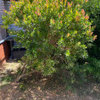Kangaroo Apple (Solanum aviculare)
sirjess
15 years ago
Featured Answer
Sort by:Oldest
Comments (24)
gregaryb
15 years agoRelated Discussions
WANTED: Unusual Solanaceae
Comments (14)I have Solanum integrifolium...."Pumpkin on a Stick", which I've heard referred to as a decorative eggplant. But it is a different species than the "normal" eggplants I grow. I also have several colors and shapes of "normal" eggplants if you are looking for any "kinda" unusual Solanaceae. And maybe if I look around, I'll find another type. I remember a very spiny eggplant-like plant from a year or two ago, but can't remember what it was. I am very busy in September and would not be interested in working out a trade until October. I grew rocoto peppers a few years back. I agree with Tom that they are very interesting and beautiful plants and fruit. You would have a unique plant with them. GW has some photos (April 22, 2007) in an old hot pepper forum post I've linked below, also some overwintering info. Tom, you might try pruning your rocoto way back to overwinter it...maybe wait for the pods to mature and then hack, er, prune, it way back so it doesn't become too much of a space hog during the winter. I've had massively trimmed peppers survive and produce much earlier after overwintering. But I got sick of battling aphids on the indoor plants and haven't overwintered recently. If I'm remembering correctly, the rocoto's weren't as dependent on hot weather for good growth as many of the other peppers types, and they may have been heat and daylength sensitive for flower/fruit set. Here is a link that might be useful: Rocoto Peppers This post was edited by naturegirl_2007 on Thu, Aug 28, 14 at 15:51...See MoreHave: Kangaroo Apple (Solanum lanceolatum)
Comments (3)Hi Karyn, I'd love a trade of these. What are you looking for in exchange? Blessings, Angela...See MorePurple berries - what is it?
Comments (9)Thanks for all the responses. I did more Googling and looking at pictures, and I believe you're all right, this is probably a West Indian Nightshade, based on the glossiness of the purple berries. Be assured that I have no intention of eating any part of this plant (nor do I have any children who might be tempted to eat the berries AND my yard is fenced and locked so no one else can get in), but the mockingbirds love the berries and evidently aren't harmed by them, so I'd like to see if I can get at least a couple of plants going for the birds next year. When doing wildlife gardening, occasionally a noxious plant or weed turns out to be a real attraction for the birds or butterflies. Several sites mentioned variations in toxicity and most agreed that a considerable amount would have to be ingested in order to cause harm, not that I have any plans to test that! Thank you all again; it's been close to keeping me up at night wondering what that plant was! Gretchen...See MoreHAVE: Olympia Fall Plant Swap
Comments (33)Teresa, you were missed. Hope you're feeling better. We'll bring your plants to the Green Elephant. Please tell LaDonna that we have her pampas grass, but I thought it was yours, so I didn't pass it along to her. We'll bring that to the GE, too. Rachel, thanks for coming. I have a trade every September. I used to have one in April, too, but I think last spring's was the last one I'm having, because it's too much trouble to haul the plants. Barb and Don Engel have one in Kelso every spring, so we decided to divide the labor. They usually post on GardenWeb, so be on the lookout beginning in April. See you at the Green Elephant, and if I need help hauling plants, I'll give you a holler. Barb and Don, hope you're enjoying your family time. Most of your plants were given away, with the exception of the Kerria, but it'll be very popular at the March Green Elephant. Drive safely home, and see you in November. Tammy/bejoy2...See Moregregaryb
15 years agotrish_g
15 years agoriku
14 years agotrooper_jay
13 years agogolden_wattle
13 years agoemily_aust
13 years agojon_p_mcdowell_yahoo_com
13 years agodragonscale112_gmail_com
13 years agoCoreanut
12 years agoTotara01
10 years agobeebumble2012
8 years agoWoko
8 years agobeebumble2012
8 years agoWoko
8 years agobeebumble2012
8 years agoyngwiewithteeth
8 years agoWoko
8 years agodremmacopp
8 years agolast modified: 8 years agoWoko
8 years agoartsruc
8 years agogregaryb
8 years agoAngela Broeders
last month
More Discussions




sirjessOriginal Author